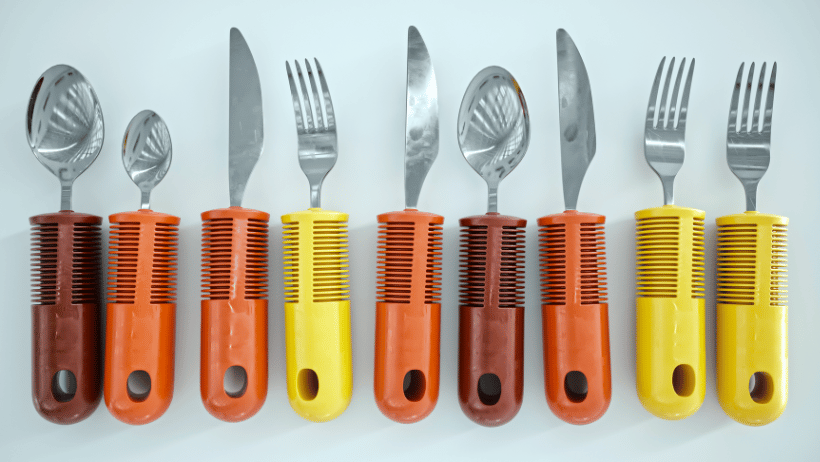Parkinson’s disease is a progressive neurological condition characterized by unintended and uncontrollable tremors. While tremors may start as small shakes in the hands, they become worse and can begin to interfere with tasks of daily living — like brushing your hair or folding your clothes. However, there are different assistive technologies out there that are designed to empower adults with Parkinson’s disease and help them maintain independence and safety at home.
Meal Preparation & Feeding Aids
Due to tremors, it can be difficult and even dangerous for seniors with Parkinson’s disease to be in the kitchen. A small slip of a knife could result in serious injury. Tremors can also make it difficult for a senior to feed themselves because it requires fine motor skills.
Here are some types of assistive devices designed to help seniors with Parkinson’s disease remain safe and independent in the kitchen.
- Eating utensils: Utensils for Parkinson’s are designed with larger, weighted handles that are easy to grip. Some can even counteract the movement of tremors, making it easier for seniors to remain independent.
- Plate guards: Plate guards are attachments that can be added to plates to keep food from spilling off the edges. It provides a barrier that seniors can use to help scoop their food onto an eating utensil.
- Rocker knife: Traditional kitchen knives can become a hazard. A rocking knife can be a safer option because it doesn’t require the same fine motor skills. It has a rounded blade and a handle on the top for easier grasp and control. People with Parkinson's can rock the knife back and forth with one hand to cut.
- Adaptive cutting board: To help keep food items in place while cutting, adaptive cutting boards have spikes. Seniors can put the food item onto a spike to keep it secure, instead of having to use their hand. Boards also come with grips on the bottom to keep them from moving around.
RELATED CONTENT: Understanding & Managing Parkinson’s Disease
Bathing & Grooming Aids
Tremors can make it hard to complete a daily grooming routine, especially when it comes to shaving. Here are some assistive tools that can help.
- Electric toothbrush: An electric toothbrush can make brushing easier and more effective for seniors with Parkinson’s. Listening to music while brushing teeth can also help calm tremors or break a freezing spell.
- Electric razor: To avoid cuts and make shaving easier, invest in an electric razor.
- Shower chair: If Parkinson’s is affecting balance and stability, put a shower chair in the shower. This simple device can help reduce the risk of falls.
- Magnetic fasteners: Buttons can become hard to use as tremors get more severe. Adaptive clothing has magnetic fasteners to help ease the struggles of getting dressed. You can even swap out buttons on existing clothing with these types of magnetic closures.
- Button aid or zipper pull: If you don’t want to use magnetic fasteners, there are weighted button aids and zipper pulls that can assist seniors with getting dressed.
- Shoehorn: A shoehorn can help guide the foot into a pair of shoes, allowing seniors with Parkinson’s to complete their dressing routine with ease.
- Velcro shoes: It may be best to invest in shoes with Velcro instead of traditional laces or buckle fasteners.
Speech & Communication Tools
Parkinson's can affect a senior's ability to communicate, too. It can cause seniors to speak in a quiet voice, slur words, mumble, or start to trail off at the end of a sentence. Tremors can also impact a senior's ability to type on a computer or phone, which has become a huge part of our daily communication.
To help seniors maintain clear communication, here are some tools to try.
- Writing tools: Parkinson’s can make it difficult to write legibly. To help, there are writing devices that are weighted or have a larger handle to help reduce the effect of tremors.
- Voice amplifier: Seniors with Parkinson’s may begin to speak very softly. A voice amplifier can help them be heard, especially in social gatherings or when talking on the phone.
- Computer gear: If a senior uses the computer frequently, then an adaptive keyboard can be a great option to make sure they can still communicate or surf the web on their computer. These keyboards have larger buttons to help reduce mistakes. A touchpad or joystick can be a good alternative to the traditional computer mouse.
Home Safety Aids
If a senior with Parkinson's is living at home, you may worry about their safety and ability to perform simple tasks, like turn off the stove. Home safety aids can help.
- Voice-activated appliances: To help remain safe at home, a senior with Parkinson’s may benefit from voice-activated appliances. With these devices, you can simply say what you need instead of trying to press small buttons or turn knobs.
- Smart home technology: In addition to voice-activated appliances, smart technology can help a senior remain safe and comfortable at home. Devices like Google Nest or Alexa can connect with smart devices to help seniors with daily tasks, like controlling the thermostat, setting a security alarm, turning off the lights, and more.
RELATED CONTENT: 8 Ways Smart Homes are Perfect for Seniors
Mobility Aids
Parkinson’s disease causes damage to the area of the brain that is responsible for movement. As the disease progresses, individuals may move more slowly or notice stiffness in the joints. They may start to lose balance and begin shuffling for added stability. However, these changes ultimately limit mobility and can lead to a dangerous fall.
To help seniors with Parkinson’s safely remain mobile, here are some types of mobility aids available.
- Cane: Canes can provide added stability while walking and can be great for seniors in the early stages of Parkinson’s disease. However, they should be a proper height. Typically, straight canes are more effective for seniors with Parkinson’s.
- Walker or rollator: Walkers and rollators provide more stability than a cane and may be more suitable for seniors as the disease progresses. Again, proper height is key to maximizing mobility and safety. Rollators have 4 wheels and may be easier to maneuver.
- Wheelchair or scooter: During the late stage of Parkinson’s disease, an individual may require a wheelchair or scooter to remain mobile.
These devices can be great resources for seniors with Parkinson's to help them be independent for as long as possible. However, as the disease progresses, seniors may require additional assistance. If your loved one has advanced Parkinson’s disease, reach out to your local Caring Senior Service. Our professional caregivers can be a helping hand to your loved one, allowing them to continue living at home.


